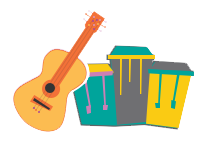
Keywords: bonjour (hello)
NO CHORDS
Read script for instructions.
Keywords: bonjour (good morning)
NO CHORDS, use drum
Bon-bon-bon-bonjour
Bon-bon-bon-bonjour
Bon-bon-bon-bonjour
Bonjour, (name)
Keywords: bonjour (hello), comment ça va? (how are you?), merci (thank you), très bien (very well)
D————————-G
Bonjour, bonjour, comment ça va?
A7——–D
Très bien!
x4
G——–D
Et toi, comment ça va?
————A7————————D—A7—D
Je vais très bien moi aussi, merci
x2
D—G—-A7
Tu vas bien? Bien, bien, bien!
D—G—-A7
Je vais bien! Bien, bien, bien!
———————G———-A7——–D
Maintenant nous allons chanter
G——D
La la la la la la
——–G—-A7—-D
La la la la la la la
x2
Keywords: ranger (clean up)
Sais-tu quelle heure il est?
Bb———————————–F7————-Bb
C’est l’heure de ranger, de ranger, de ranger
—————————————F7—————————-Bb
C’est l’heure de ranger, c’est l’heure de ranger
F7—————————-Bb
C’est l’heure de ranger
Keywords: fraises (strawberries), ici (here), là (there)
D
Fraises, fraises, fraises
D
J’aime les fraises
G
Elles sont jolies
D————————————A7
On les trouve dans la forêt
On les trouve ici, là, et là
Keywords: chanter (to sing), danser (to dance), applaudir (to clap)
Chanter! (spoken)
D—————————A————————-D
Nous allons chanter, chanter, chanter
x4
Danser! (spoken)
D————————-A————————D
Nous allons danser, danser, danser
x4
Applaudir! (spoken)
D——————————A———————————D
Nous allons applaudir, applaudir, applaudir
x4
Keywords: écoute (listen)
G———————C
Écoute, écoute
C——————-G————C
Ce que fait le vent
x2
——————-G————C
Maintenant c’est à toi
————————G———–C———-D
Et maintenant c’est à toi
G———————C
Écoute, écoute
C——————-G————C
Le bruit de la pluie
x2
——————-G————–C
Maintenant c’est à toi
————————G———–C———-D
Et maintenant c’est à toi
G———————C
Écoute, écoute
——————-G————C
Le son de la mer
——————-G————–C
Maintenant c’est à toi
————————G———–C———-D
Et maintenant c’est à toi
G———————C
Écoute, écoute
G———————C
écoute, écoute
G
Écoute
Keywords: au revoir (goodbye), mes amis (my friends)
D—————————————————G
Au revoir mes amis, au revoir, au revoir
———————-D——————————A—————————-D
Au revoir mes amis, au revoir mes amis, au revoir, au revoir
x2
——————–G—————————-D
J’espère te revoir bientôt bientôt
——————-A———————————-D
Avec plus d’amis pour jouer ensemble
———————-G————————D
J’espère te revoir bientôt bientôt
——————-A—————————–D
Avec plus d’amis pour faire la fête
D—————————————————G
Au revoir mes amis, au revoir, au revoir
———————-D——————————A—————————-D
Au revoir mes amis, au revoir mes amis, au revoir au revoir
C—————F———–C———————G
Les étoiles brillent, un, deux, trois, quatre
—–Am—–F————–C——-G
Je fais un voeux et un autre
C———–F——-C—————–G
Une fée arrive tout près de moi
Am——-F—————-C————–G
Elle me dit repose toi
C———————————F———————-C—-G
Je rêve que je monte près des nuages
—–Am————F—————–C——–G
Je suis à côté des étoiles
x2
C———————-F————C—G
Ouh-ouh-ouh………
—–Am————F—————–C——–G
Ouh-ouh-ouh………
C———————————F———————-C—-G
Je rêve que je monte près des nuages
—–Am————F—————–C——–G
Je suis à côté des étoiles
x2
C———————-F————C—G
Ouh-ouh-ouh………..
—–Am————F—————–C——–G——–C
Ouh-ouh-ouh………..
Keywords: un (one), deux (two), trois (three), mon numéro préféré (my favorite number)
D———————G———–A———–D
Mon numéro préféré est le trois x2
G——-D——A——-D
Trois amis à Paris x2
NO CHORD
Combien d’amis? Trois! Un, deux, trois x2
D———————G———–A———–D
Mon numéro préféré est le trois x2
G——-D——A——-D
Trois crêpes au Québec x2
NO CHORD
Combien de crêpes? Trois! Un, deux, et trois x2
D———————G———–A———–D
Mon numéro préféré est le trois x2
G——-D——A——-D
Trois cigales au Sénégal x2
Combien de cigales? Trois! Un, deux, et trois x2
D———————G———–A————-D
Mon numéro préféré est le trois x2
G——-D——A——D—–G——-D——-A—-D———-G——–D——A
Trois amis à Paris, trois crêpes au Québec, trois cigales au
——-D
Sénégal
G————————-D—-A———–D
Mon numéro préféré est le trois x2
NO CHORDS
Un, deux, et trois!
Keywords: fête (party)
C
Voici le moment que j’attendais, la fête
—————————————-G7
La fête va enfin commencer, la fête
F————G7———–C—————F————————G7
J’ai invité mes amis, on va tous bien s’amuser
F————G7———–C—————-F———–G7———C
J’ai invité mes amis, on va tous bien s’amuser
G7————————————-C
On va tous très bien manger, la fête
G7——————————-C——-C7
Tout le monde va danser
F———–G7——C———————–F——–D7———–G
J’ai invité mes amis, ma famille et mes voisins pour jouer
F———–G7——C———————–F——–G7———–C—–C7
J’ai invité ma famille et mes voisins pour jouer
————–F——————C————————F————-D7—G
Voilà voilà, voilà voilà, qu’est-ce que j’aime faire la fête!
————–F——————C————————F———–G7——-C
Voilà voilà, voilà voilà, qu’est-ce que j’aime faire la fête!
Keywords: bonjour (hello)
PREPARE:
PERFORM
Keywords: bonjour (good morning)
PREPARE:
PERFORM
Keywords: bonjour (hello), comment ça va? (how are you?), merci (thank you), très bien (very well)
PREPARE:
PERFORM
CHALLENGE
Keywords: ranger (clean up)
PREPARE:
PERFORM
Keywords: fraises (strawberries), ici (here), là (there)
PREPARE:
PERFORM
Keywords: chanter (to sing), danser (to dance), applaudir (to clap)
PREPARE:
PERFORM
CHALLENGE
Keywords: écoute (listen)
PREPARE:
PERFORM
CHALLENGE
Keywords: au revoir (goodbye), mes amis (my friends)
PREPARE:
PERFORM
PREPARE:
PERFORM
Keywords: un (one), deux (two), trois (three), mon numéro préféré (my favorite number)
PREPARE:
PERFORM
CHALLENGE
Keywords: fête (party)
PREPARE:
PERFORM
CHALLENGE
Keywords: en haut (up), en bas (down), dedans (inside), dehors (outside), petit (small), grand (big), un (one), deux (two), trois (three), quatre (four), cinq (five), six (six), sept (seven), huit (eight), neuf (nine), dix (ten)
PREPARE:
PERFORM
Bring out the Parachute
Puppet and Parachute
Keywords: fraises (strawberries), ici (here), là (there)
PREPARE:
PERFORM
Goodbye to Parachute